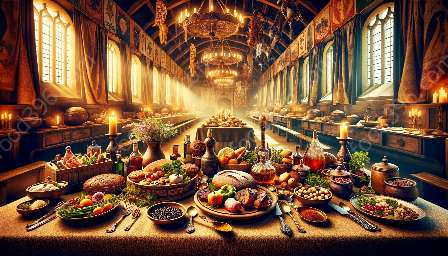Food and cuisine in medieval literature and art offer a captivating glimpse into the historical and cultural significance of culinary traditions. Through an exploration of the foods, feasts, and dining customs depicted in medieval writings and artworks, we can gain insight into the social, symbolic, and sensory dimensions of culinary experiences during this fascinating era.
The Historical Context of Medieval Cuisine
Medieval cuisine was deeply intertwined with the social, economic, and religious aspects of life. In the context of the medieval period, which spanned roughly from the 5th to the 15th century, food and culinary practices were not only sustenance but also integral elements of feasting, religious rituals, and social hierarchies. Food was central to the medieval cultural identity, reflecting the diverse agricultural, trade, and culinary traditions that existed across different regions of Europe.
Cultural Connections in Medieval Cuisine
The culinary customs of the medieval period were influenced by a variety of factors, including trade routes, conquests, religious edicts, and seasonal availability of ingredients. This confluence of influences resulted in a rich tapestry of flavors, ingredients, and cooking techniques that varied across geographical regions. For instance, the cuisine of medieval England differed from that of medieval France or Italy, each with its own distinct culinary practices and traditions.
Symbolism and Significance in Medieval Food
Food in medieval literature and art often served as a symbol of social status, spirituality, and communal bonds. Feasting and food-related activities were prominent themes in medieval narratives, serving as markers of hospitality, abundance, or deprivation. From lavish banquets in royal courts to humble meals in peasant households, the depiction of food in medieval texts and visual art offers a nuanced understanding of social dynamics and cultural values.
Medieval Cuisine in Literature
Medieval literature, including epic poems, romances, and allegorical works, frequently showcased the role of food in shaping narratives and characters. Feasts and culinary offerings often served as backdrops for pivotal moments, such as celebrations, alliances, or betrayals. The descriptions of food and dining rituals in medieval literature provide valuable insights into the ideals of hospitality, courtly etiquette, and gastronomic pleasures that permeated the medieval imagination.
Medieval Cuisine in Art
Artworks from the medieval period, including illuminated manuscripts, paintings, and tapestries, offer visual representations of food, feasting, and culinary settings. These artistic depictions not only captured the materiality of medieval cuisine but also conveyed symbolic meanings associated with food and dining. Through the intricate details of food presentation, table settings, and communal gatherings, medieval art provides a window into the sensory experiences and cultural values associated with food during this era.
Legacy of Medieval Cuisine
The legacy of medieval cuisine continues to resonate in contemporary culinary traditions, influencing the regional cuisines and culinary practices of modern-day Europe. By studying the role of food and cuisine in medieval literature and art, we can gain a deeper appreciation for the historical, cultural, and sensory dimensions of food that have shaped human experiences for centuries.

